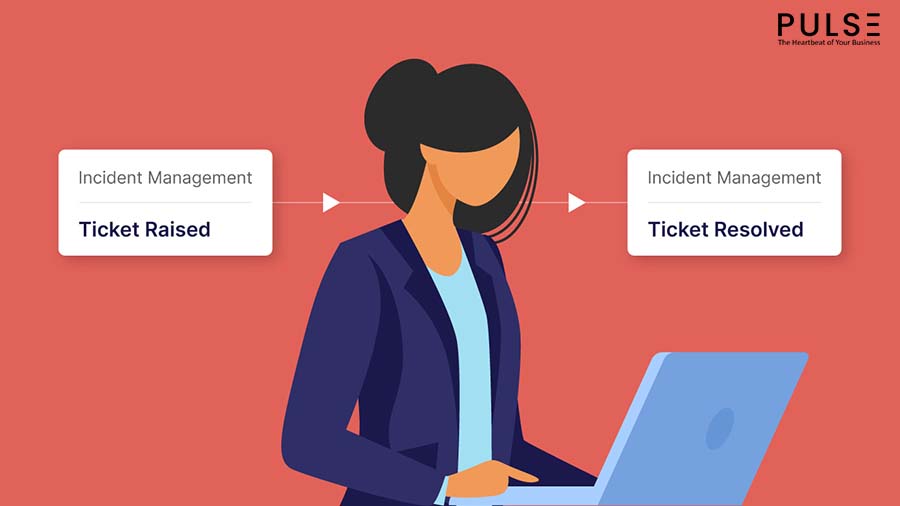You might be able to recall a day or days when technology backfired at your workplace. For example, you were hardly done reporting the jammed printer when you received a call about undelivered bulk emails.
These daytime nightmares are common in the workplace. But the relief is, they’re manageable with correct incident management software. No wonder, from 2020 to 2025, the Incident and Emergency Management Software Market is expected to reach $124.2 billion, increasing at a CAGR of 5.4 percent.
Incident management is perhaps the best way to ensure critical data is logged in immediately and that issues are addressed in real-time. Read on to know seven incident management best practices that can positively influence productivity levels at your workplace.
Incident Management Best-Practices to Boost Productivity

1. Incident Logging
To set up a reactive incident management system, your first step is to ensure that incidents are immediately logged in. Next, ensure that your incident management software is user-friendly and has flexible templates to categorize service requests based on urgency and intensity.
You can choose software that empowers your end-users to log incidents directly. Check out the range of easy-to-use templates at Pulse that can smoothen your Incident Logging Practices at Work.
2. Know Your Priorities
An efficient incident management software will allow you to classify tickets based on the urgency of ticket resolution. A system of initial diagnosis that can escalate to advanced diagnosis is essential for prioritizing issues in your incident management system.
Linking an incident with the respective Configuration Item (CI) will lead to a speedier diagnosis. Software that assists in creating a Priority Matrix for your organization will help you identify critical requests quickly.
Assigning customized values to input impact and urgency will help you calibrate crisis-level incidents and separate them from medium and low-priority incidents at the workplace.
You don’t want to delay an issue raised by the CEO because you were engrossed in resolving the backup printer repair ticket!
3. The Importance of Closure
Once a ticket is raised and relevant information has reached the IT experts, the logical next step is ticket resolution and closure. Again, incident management requires this process to be highly efficient and quick.
While many organizations choose a system of manual updates, you can choose from a variety of efficient software that can exponentially speed up the process of resolution. Book a free demo with Pulse, to experience smooth incident management and ticket resolution.
4. Know Your User
For incident management to be successful at your workplace, you need to know your end-user well. Whether the end-user is an employee, customer, agent, or another stakeholder, your incident management portal must record and manage all user profiles.
Manually updating user profiles is time-consuming, error-prone, and tedious. A sturdy audit management software with a good incident management portal can save you hours of manual work.
You can choose a third-party integration provider such as Pulse to assist in updating/migration and management of user profiles.
5. Automate Ticket Assignments
Once an end-user raises a ticket, you are probably left to delegate the resolution duty to one IT team member. In a larger group, this can lead to unfair distribution of work and erratic assignment of tickets.
If you wish to simplify the process of ticket assignment, you should opt for automation. Not only is it a time-saver, but it can also free you from taking decisions related to workload distribution and ensure a fair and efficient process.
You can also create a system that provides advance notification to solution-providers/ resolution agents.
6. Knowledge is Key
Incident management is a continuous and reactive process. So naturally, you want to minimize incidents with team members in the workplace, but it is difficult to achieve a zero-incident workplace.
Occasionally, emails will bounce, networks will die out, and machines will be uncooperative.
While you can create a smooth incident management system by relying on efficient software, you can also foresee specific frequently occurring issues and empower your end-users with knowledge.
The integration of knowledge management with incident management can significantly improve FCR.
7. Trust the Template
Customized templates can help you to provide your end-users with a range of relevant and easy-to-use templates. In addition, templates can improve the user experience through notifications, resolution status displays, and new comments.
Furthermore, you can configure notifications through multi-channel communication avenues such as e-mails, SMS, mobile, and so on.
You can pre-decide specific fixed responses for frequent issues or ensure better interaction within the solution-providing using customized templates agents’ team.
You can become an incident management expert at your workplace by following these best practices. Identifying issues and obstacles proactively is the only way to pave the path for a quick resolution.
Not only does a sound incident management system ensure timely identification and resolution of issues, but it also ensures process adherence and can help you to meet SLAs.
Good software can allow you to meet best practices with minimal wastage of time, effort, and resources.
If you are exploring the third party for your incident management systems at work, it might be a good idea to connect with an expert from Pulse. Click here to get in touch with an expert at Pulse and pave your way into incident-management heaven.
